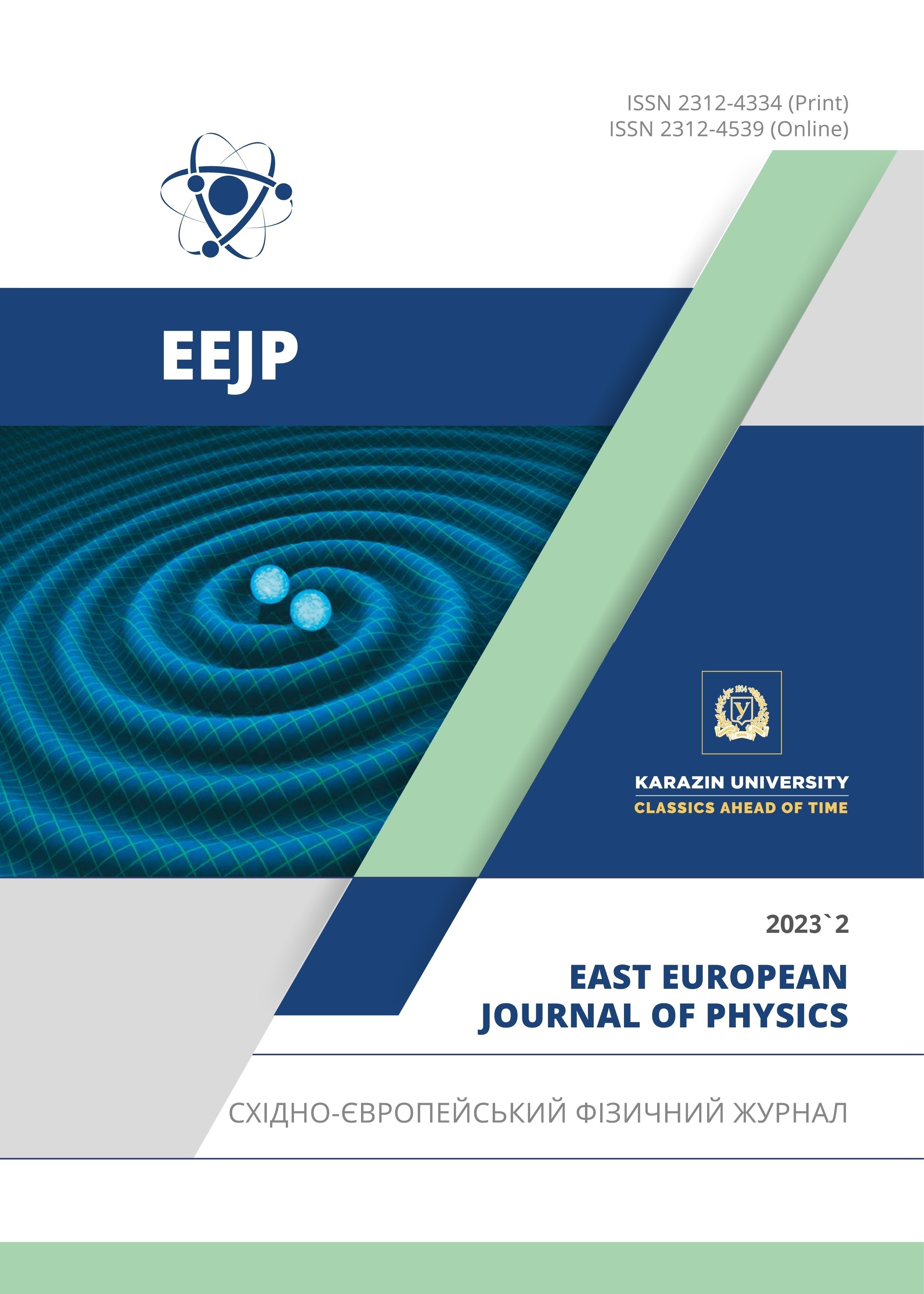Про необхідність обліку власних полів випромінювачів при описі режимів генерації
Анотація
У роботі обговорюються три різні режими генерації електромагнітного поля ансамблем осциляторів, розміщених на довжині хвилі випромінювання в одновимірному випадку. Розглянуто збудження резонаторного поля, яке, як правило, визначається геометрією системи, з урахуванням та без урахування власних полів випромінювачів. Аналізується також режим надвипромінювання такого ж ансамблю осциляторів. Фактично надвипромінювання формується за рахунок власних полів випромінювачів навіть без резонатора. Зазначається, що максимально можливі амплітуди індукованих полів як у режимі надвипромінювання, так і в режимі генерації поля резонатора можна порівняти. Це змушує подумати про роль власних полів випромінювачів у приладах електроніки. Наголошується на помилковості традиційного підходу до опису збудження резонаторів і хвилеводів, де облік суми власних полів випромінювачів не проводився. Показано, що при коректному описі режиму збудження резонатора, крім поля резонатора, необхідно враховувати також суму власних полів випромінювачів в активній зоні. Синхронізація випромінювачів також, як і в режимі надвипромінювання, приводить до появи значної амплітуди індукованого поля системи осциляторів. Показано, що в практично цікавому випадку відкритих систем (дисипативні режими генерації) цей облік помітно зменшує характерний час розвитку генерації, збільшує максимально можливу амплітуду коливань. Облік власних полів випромінювачів також змінює умови досягнення максимального потоку енергії із системи. Це здатне змінювати робочу точку процесу генерації, що визначається вимогою максимального темпу виведення енергії із системи.
Завантаження
Посилання
A. NordSieck, “Theory of large Signal Behavior of Travelingwave amplifiers,” Proc. IRE, 41(5), 630-631 (1953). https://doi.org/10.1109/JRPROC.1953.274404
V.D. Shapiro, and V.I. Shevchenko, “Interaction of a wave-part in nonequilibrium media,” Radiophysics and Quantum Electronics, 19, 543-560 (1976). https://link.springer.com/article/10.1007/BF01034470
A.N. Kondratenko, and V.M. Kuklin, Fundamentals of plasma electronics, (Energoatomizdat, Moscow, 1988). https://www.researchgate.net/publication/367500092_Osnovy_Plazmennoj_Elektroniki
R.J. Briggs, Electron-Stream Intection with Plasmas, (MIT Press, Cambridge, 1964).
V.U. Abramovich, and V.I. Shevchenko, “Nonlinear Theory of Dissipative Instability of a Relativistic Beam in a Plasma” Soviet physics JETP, 35(4), 730-732 (1972). http://www.jetp.ras.ru/cgi-bin/dn/e_035_04_0730.pdf
A.N. Kondratenko, V.M. Kuklin, and V.I. Tkachenko, “Nonlinear theory of fuel instability in the collision plasma,” Izv. Universities. Radiophysics, 21(10), 1535-1537 (1978). https://radiophysics.unn.ru/sites/default/files/papers/1978_10_1535.pdf
A.G. Zagorodniy, A.V. Kirichok, V.M. Kuklin, and A.V. Priymak, “Modulation of the integral field of multi-muddy beams in plasma,” East Eur. J. Phys. 1(2), 53-66 (2014). https://periodicals.karazin.ua/eejp/article/view/129/40. (in Russian)
V.L. Ginzburg, “Radiation of evenly moving sources (Vavilov-Cherenkov effect, transitional radiation and some other phenomena),” UFN, 166(10), 1033-1042 (1996). http://elibrary.lt/resursai/Uzsienio%20leidiniai/Uspechi_Fiz_Nauk/1996/10/r9610a.pdf. (in Russian)
V.M. Kuklin, “On the Nature of Coherens in the System of Oscillators,” PAST, 4, 91-95 (2019). https://vant.kipt.kharkov.ua/ARTICLE/VANT_2019_4/article_2019_4_91.pdf
R.N. Dicke, “Coherence in Spontaneous Radiation Processes,” Physical Review, 93(1), 99-110 (1954). https://doi.org/10.1103/PhysRev.93.99
V.M. Kuklin, D.N. Litvinov, S.M. Sevidov, and V.E. Sporov, “Simulation of Synchronization of Nonlinear Oscillators by the External Field,” East Eur. J. Phys. 4(1), 75-84 (2017). https://periodicals.karazin.ua/eejp/article/view/8561
Kuklin V.M., D.N. Litvinov, and V.E. Sporov, “Superradiance of Stationary Oscillators,” PAST, 4(116), 217-220 (2018). https://vant.kipt.kharkov.ua/ARTICLE/VANT_2018_4/article_2018_4_217.pdf
V.M. Kuklin, and E.V. Poklonskiy, “Dissipative Instabilites and Superradiation Regimes (Classic Models),” PAST, 4(134), 138-143 (2021). https://vant.kipt.kharkov.ua/ARTICLE/VANT_2021_4/article_2021_4_138.pdf
V.M. Kuklin, Selected Chapters (Theoretical Physics), (V.N. Karazin Kharkiv National University publishing, Kharkiv, 2021). http://dspace.univer.kharkov.ua/handle/123456789/16359
A.N. Didenko, V.P. Grigoryev, and Yu.P. Usov, Powerful electronic beams and their use, (Atomizdat, Moscow, 1977). (in Russian)
M.V. Kuzelev, and A.A. Rukhadze, Electrodynamics of dense electron beams in plasma, (Nauka, Moscow, 1990).
Авторське право (c) 2023 Володимир М. Куклін, Євген В. Поклонський

Цю роботу ліцензовано за Міжнародня ліцензія Creative Commons Attribution 4.0.
Автори, які публікуються у цьому журналі, погоджуються з наступними умовами:
- Автори залишають за собою право на авторство своєї роботи та передають журналу право першої публікації цієї роботи на умовах ліцензії Creative Commons Attribution License, котра дозволяє іншим особам вільно розповсюджувати опубліковану роботу з обов'язковим посиланням на авторів оригінальної роботи та першу публікацію роботи у цьому журналі.
- Автори мають право укладати самостійні додаткові угоди щодо неексклюзивного розповсюдження роботи у тому вигляді, в якому вона була опублікована цим журналом (наприклад, розміщувати роботу в електронному сховищі установи або публікувати у складі монографії), за умови збереження посилання на першу публікацію роботи у цьому журналі.
- Політика журналу дозволяє і заохочує розміщення авторами в мережі Інтернет (наприклад, у сховищах установ або на особистих веб-сайтах) рукопису роботи, як до подання цього рукопису до редакції, так і під час його редакційного опрацювання, оскільки це сприяє виникненню продуктивної наукової дискусії та позитивно позначається на оперативності та динаміці цитування опублікованої роботи (див. The Effect of Open Access).








